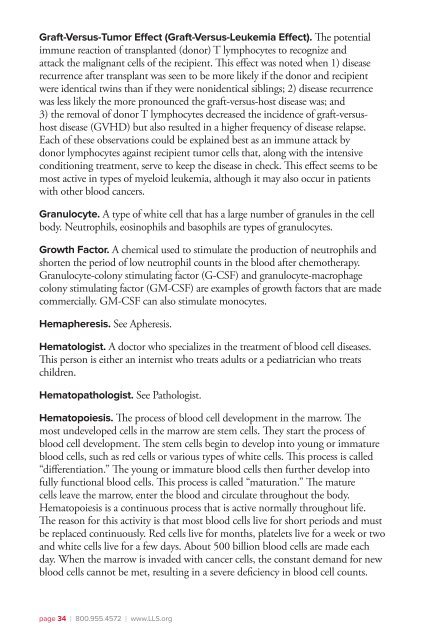Chronic Lymphocytic Leukemia - The Leukemia & Lymphoma Society
Chronic Lymphocytic Leukemia - The Leukemia & Lymphoma Society
Chronic Lymphocytic Leukemia - The Leukemia & Lymphoma Society
You also want an ePaper? Increase the reach of your titles
YUMPU automatically turns print PDFs into web optimized ePapers that Google loves.
Graft-Versus-Tumor Effect (Graft-Versus-<strong>Leukemia</strong> Effect). <strong>The</strong> potential<br />
immune reaction of transplanted (donor) T lymphocytes to recognize and<br />
attack the malignant cells of the recipient. This effect was noted when 1) disease<br />
recurrence after transplant was seen to be more likely if the donor and recipient<br />
were identical twins than if they were nonidentical siblings; 2) disease recurrence<br />
was less likely the more pronounced the graft-versus-host disease was; and<br />
3) the removal of donor T lymphocytes decreased the incidence of graft-versushost<br />
disease (GVHD) but also resulted in a higher frequency of disease relapse.<br />
Each of these observations could be explained best as an immune attack by<br />
donor lymphocytes against recipient tumor cells that, along with the intensive<br />
conditioning treatment, serve to keep the disease in check. This effect seems to be<br />
most active in types of myeloid leukemia, although it may also occur in patients<br />
with other blood cancers.<br />
Granulocyte. A type of white cell that has a large number of granules in the cell<br />
body. Neutrophils, eosinophils and basophils are types of granulocytes.<br />
Growth Factor. A chemical used to stimulate the production of neutrophils and<br />
shorten the period of low neutrophil counts in the blood after chemotherapy.<br />
Granulocyte-colony stimulating factor (G-CSF) and granulocyte-macrophage<br />
colony stimulating factor (GM-CSF) are examples of growth factors that are made<br />
commercially. GM-CSF can also stimulate monocytes.<br />
Hemapheresis. See Apheresis.<br />
Hematologist. A doctor who specializes in the treatment of blood cell diseases.<br />
This person is either an internist who treats adults or a pediatrician who treats<br />
children.<br />
Hematopathologist. See Pathologist.<br />
Hematopoiesis. <strong>The</strong> process of blood cell development in the marrow. <strong>The</strong><br />
most undeveloped cells in the marrow are stem cells. <strong>The</strong>y start the process of<br />
blood cell development. <strong>The</strong> stem cells begin to develop into young or immature<br />
blood cells, such as red cells or various types of white cells. This process is called<br />
“differentiation.” <strong>The</strong> young or immature blood cells then further develop into<br />
fully functional blood cells. This process is called “maturation.” <strong>The</strong> mature<br />
cells leave the marrow, enter the blood and circulate throughout the body.<br />
Hematopoiesis is a continuous process that is active normally throughout life.<br />
<strong>The</strong> reason for this activity is that most blood cells live for short periods and must<br />
be replaced continuously. Red cells live for months, platelets live for a week or two<br />
and white cells live for a few days. About 500 billion blood cells are made each<br />
day. When the marrow is invaded with cancer cells, the constant demand for new<br />
blood cells cannot be met, resulting in a severe deficiency in blood cell counts.<br />
page 34 I 800.955.4572 I www.LLS.org

















